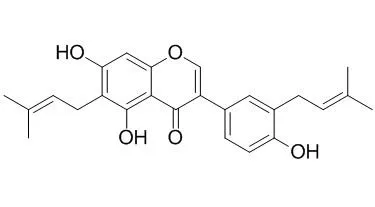| Cell Research: |
| Anticancer Res. 2015 May;35(5):2827-34. | | Lupalbigenin from Derris scandens Sensitizes Detachment-induced Cell Death in Human Lung Cancer Cells.[Pubmed: 25964563 ] | The ability of cancer cells to resist to anoikis has been shown to augment cancer cell metastasis in many cancers. In search for potential substances for anti-metastatic approaches, this study aimed to investigate anoikis-sensitizing activity of Lupalbigenin, extracted from Derris scandens.
METHODS AND RESULTS:
Human lung cancer cells were treated with non-cytotoxic concentrations of Lupalbigenin in a detachment condition. Anoikis was evaluated at various time points using MTT viability assays. The effect of Lupalbigenin on anchorage-independent growth was performed by soft-agar assay. The survival signaling proteins, as well as regulatory proteins of apoptosis and metastasis, were examined by western blot analysis. Lupalbigenin treatment significantly down-regulated survival proteins, including protein kinase B (pAKT/AKT) and extracellular signal-regulated kinase (pERK/ERK), as well as anti-apoptotic protein B-cell lymphoma 2 (BCL-2), resulting in the enhancement of the cellular response to anoikis and the decrease of growth and survival in an anchorage-independent condition.
CONCLUSIONS:
Lupalbigenin sensitizes detachment-induced cell death in human lung cancer cell through down-regulation of pro-survival proteins. | | Biol Pharm Bull. 2016;39(4):631-5. | | Bioassay-Guided Isolation of Two Flavonoids from Derris scandens with Topoisomerase II Poison Activity.[Pubmed: 26754253 ] | Derris scandens (ROXB.) BENTH. (Fabaceae) is used as an alternative treatment for cancer in Thai traditional medicine. Investigation of the topoisomerase II (Top2) poison of compounds isolated from this plant may reveal new drug leads for the treatment of cancer.
METHODS AND RESULTS:
Bioassay-guided isolation was performed on an extract of D. scandens stems using a yeast cell-based assay. A yeast strain expressing the top2-1 temperature-sensitive mutant was used to assay Top2 activity. At the permissive temperature of 25°C, yeast cells were highly sensitive to Top2 poison agents. At the semi-permissive temperature of 30°C, where enzyme activity was present but greatly diminished, cells displayed only marginal sensitivity. The bioassay-guided fractionation of the extract led to the isolation of two known isoflavones: 5,7,4'-trihydroxy-6,8-diprenylisoflavone (1) and Lupalbigenin (2). These two compounds also displayed cytotoxicity against three different cancer cell lines, KB, MCF-7 and NCI-H187.
CONCLUSIONS:
In conclusion, Top2 poison agents from D. scandens are reported for the first time, substantiating the use of D. scandens in Thai traditional medicine for cancer treatment.
|
|






 Cell. 2018 Jan 11;172(1-2):249-261.e12. doi: 10.1016/j.cell.2017.12.019.IF=36.216(2019)
Cell. 2018 Jan 11;172(1-2):249-261.e12. doi: 10.1016/j.cell.2017.12.019.IF=36.216(2019) Cell Metab. 2020 Mar 3;31(3):534-548.e5. doi: 10.1016/j.cmet.2020.01.002.IF=22.415(2019)
Cell Metab. 2020 Mar 3;31(3):534-548.e5. doi: 10.1016/j.cmet.2020.01.002.IF=22.415(2019) Mol Cell. 2017 Nov 16;68(4):673-685.e6. doi: 10.1016/j.molcel.2017.10.022.IF=14.548(2019)
Mol Cell. 2017 Nov 16;68(4):673-685.e6. doi: 10.1016/j.molcel.2017.10.022.IF=14.548(2019)